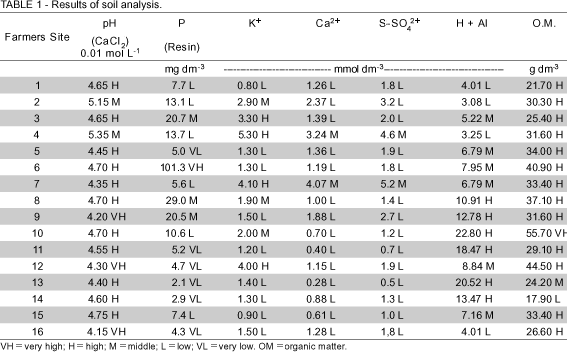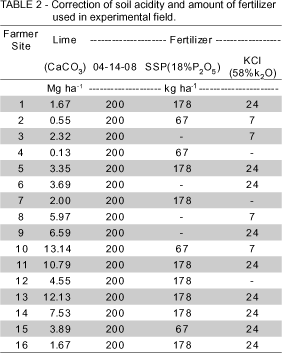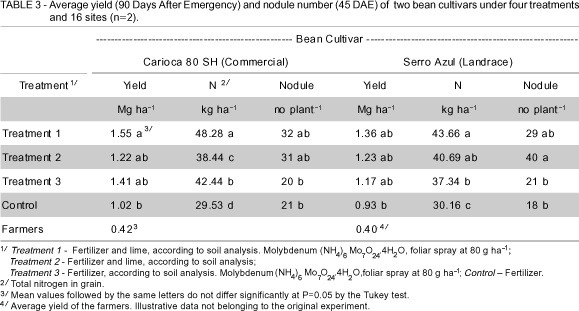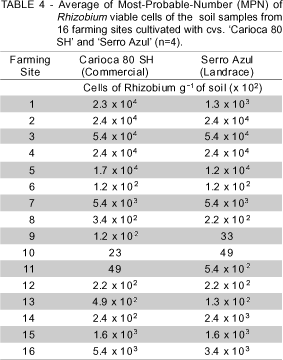Abstracts
The colonization of the State of São Paulo, Brazil of the northeastern region, is related to historical movements, such as "tropeirismo" (séc. XVIII and XIX) and Italian immigration (séc. XIX). The agriculture presently practices used by farmers descendent of immigrants does not differ from the techniques used at the beginning of the century. In the Cunha region of the Atlantic Rain Forest ecosystem poor bean yield associated with low fertilizer input, plant disease and soil erosion led to slash-and-burn farming. This work is an attempt at identifying sustainable farming practices that would minimize bean disease and maximize nitrogen assimilation. For that purpose soil fertility and plant cultivar were studied under standard agronomic practices to determine their effect on seed yield, total nitrogen of grain and number of root nodules. Fertilization, liming and molybdenum from 16 sites increased yield by 342% and 369% for the landrace `Serro Azul' and commercial variety `Carioca 80 SH', respectively. In addition, plants grown with fertilizer presented more nodules and more nitrogen in grain per hectare. The increase of crop yield per hectare might increment the family income and reduce deforestation of the Atlantic forest.
Phaseolus vulgaris; Rhizobium tropici; landrace; lime; molybdenum
A história de colonização da região do Alto Vale do Paraíba está relacionada a movimentos históricos como tropeirismo (sec. XVIII e XIX) e imigração Italiana (séc. XIX). As práticas de agricultura utilizadas pelos agricultores atuais são as mesmas utilizadas desde o início do século, e muitos dos materiais cultivados atualmente, como algumas cultivares de feijão e milho, foram trazidas pelos tropeiros em suas viagens entre Minas Gerais e Paratí. O cultivo do feijoeiro no Município de Cunha - São Paulo é caracterizado pelo baixo rendimento resultante do reduzido uso de insumos, doenças endêmicas e práticas de preparo de solo não apropriadas em áreas de topografia acidentada. Com o objetivo de identificar práticas de cultivo adequadas e maximizar a absorção do nitrogênio, foi instalado um conjunto de experimentos onde avaliaram-se o rendimento de grãos, teor de nitrogênio nos grãos e número de nódulos. A calagem e adubação mineral em 16 locais foram suficientes para aumentar o rendimento de grãos em 342% e 369% para a cultivar "crioula" Serro Azul e comercial Carioca 80 SH, respectivamente, com significativo aumento da nodulação e nitrogênio nos grãos em quantidades totais. Maior rendimento por hectare significa acréscimo na renda familiar e redução da pressão sobre as áreas de floresta remanescente (Mata Atlântica).
Phaseolus vulgaris; Rhizobium tropici; crioula; molibdênio; calagem
BEAN CULTIVATION IN A SUBSISTENCE FARMING SYSTEM IN THE NORTHEAST OF SÃO PAULO STATE - BRAZIL
Wladecir Salles de Oliveira; Siu Mui Tsai*
Lab. de Biologia Celular e Molecular-USP/CENA, C.P. 96 - CEP: 13400-970 - Piracicaba, SP.
*Corresponding author <tsai@cena.usp.br>
ABSTRACT: The colonization of the State of São Paulo, Brazil of the northeastern region, is related to historical movements, such as "tropeirismo" (séc. XVIII and XIX) and Italian immigration (séc. XIX). The agriculture presently practices used by farmers descendent of immigrants does not differ from the techniques used at the beginning of the century. In the Cunha region of the Atlantic Rain Forest ecosystem poor bean yield associated with low fertilizer input, plant disease and soil erosion led to slash-and-burn farming. This work is an attempt at identifying sustainable farming practices that would minimize bean disease and maximize nitrogen assimilation. For that purpose soil fertility and plant cultivar were studied under standard agronomic practices to determine their effect on seed yield, total nitrogen of grain and number of root nodules. Fertilization, liming and molybdenum from 16 sites increased yield by 342% and 369% for the landrace 'Serro Azul' and commercial variety 'Carioca 80 SH', respectively. In addition, plants grown with fertilizer presented more nodules and more nitrogen in grain per hectare. The increase of crop yield per hectare might increment the family income and reduce deforestation of the Atlantic forest.
Key words:Phaseolus vulgaris, Rhizobium tropici, landrace, lime, molybdenum
CULTIVO DO FEIJOEIRO SOB CONDIÇÕES DE SUBSISTÊNCIA NO NORDESTE DO ESTADO DE SÃO PAULO-BRASIL
RESUMO: A história de colonização da região do Alto Vale do Paraíba está relacionada a movimentos históricos como tropeirismo (sec. XVIII e XIX) e imigração Italiana (séc. XIX). As práticas de agricultura utilizadas pelos agricultores atuais são as mesmas utilizadas desde o início do século, e muitos dos materiais cultivados atualmente, como algumas cultivares de feijão e milho, foram trazidas pelos tropeiros em suas viagens entre Minas Gerais e Paratí. O cultivo do feijoeiro no Município de Cunha - São Paulo é caracterizado pelo baixo rendimento resultante do reduzido uso de insumos, doenças endêmicas e práticas de preparo de solo não apropriadas em áreas de topografia acidentada. Com o objetivo de identificar práticas de cultivo adequadas e maximizar a absorção do nitrogênio, foi instalado um conjunto de experimentos onde avaliaram-se o rendimento de grãos, teor de nitrogênio nos grãos e número de nódulos. A calagem e adubação mineral em 16 locais foram suficientes para aumentar o rendimento de grãos em 342% e 369% para a cultivar "crioula" Serro Azul e comercial Carioca 80 SH, respectivamente, com significativo aumento da nodulação e nitrogênio nos grãos em quantidades totais. Maior rendimento por hectare significa acréscimo na renda familiar e redução da pressão sobre as áreas de floresta remanescente (Mata Atlântica).
Palavras-chave:Phaseolus vulgaris, Rhizobium tropici, crioula, molibdênio, calagem
INTRODUCTION
The last remaining areas of the Atlantic Rain Forest Ecosystem is found in the Northeastern region of the State of São Paulo, Brazil (Ururary, 1975). Asides from its vast natural resources that region is important for its historical wealth value as the site of "tropeirismo" (séc. XVIII and XIX), the Italian immigration (séc. XIX) and revolutionary movements (revolution of 1932). The culture of the region is still preserved due to the distance to urban centers and a peculiar characteristic of preservation of habits and traditions. In agriculture, it is possible to find bean and corn cultivars brought by the tropeiros during their trips from Minas Gerais State and Parati (Figure 1). The cultivation methods introduced by the immigrants used in former Coffee farms, such as animal traction and subsistence cultivation for family maintenance, are still practiced and constitutes the current base of the local economy.
The topography of the region associated with the low soil fertility and methods of non-sustainable agriculture result in a constant exploitation of the natural resources. Common bean and corn are planted for two or tree years after clearing an area, followed by cultivation of native grasses, which is less demanding for soil nutrients. The pastures are also routinely burned to allow grass regrowth. However, within in short time, the soil is depleted of nutrients and abandoned leading to another area to be deforested, repeating the cycle. Little or no extensive work has been done in the region to control plant diseases, promote soil fertility and discourage the farmers from continuing clearing new areas.
The economy of the region is based on agriculture (bean, maize and pasture). According to Oliveira (1996), the area cultivated with common bean in the region decreased from 3400 ha in the 80's to 340 ha in 1994 in consequence of the low productivity and cost of production. According to Soria et al. (1975), a new technology available for bean production compelled some farmers to abandon the traditional farming practices. But that, it is sometimes impractical due to high costs, adverse climate conditions and limitations in topography, as in the case of the Cunha region.
Lime and pesticides are usually not used in subsistence agriculture. The acidity of local soils is one of the main limiting factors in production and biological nitrogen fixation (BNF). Fertilizer use is restricted and applied in low amounts. However, Rhizobium cells exist in amount sufficient to promote nodulation in bean plants under local conditions (Oliveira, 1996). The use of foliar spray of molybdenum is recommended to intensify the processes of nitrogen assimilation absorbed in the nitrate form; biological nitrogen fixation (Rhizobium) participating as cofactor of the two enzymatic processes. The use of molybdenum directly in acid soils is not recommended due the cation changes that render the element not unavailable for the plants root system (González, 1997).
The main purpose of this work was then to evaluate the effect of fertilizer, lime and the micronutrient molybdenum on two bean cultivars, 'Serro Azul' and 'Carioca 80 SH', in the Cunha region during the 94/95 growing season.
MATERIAL AND METHODS
Cultivars: Seeds of cv.'Serro Azul' were obtained from local farmers and cv. 'Carioca 80 SH' from the 'Governmental Seed Company of the State of São Paulo' (CATI).
Experimental Sites: Plots were established on 16 farming sites in the Cunha region. Each plot was 16.0 m x 7.0 m with two 6.0 m x 7.0 m subplots. The four treatments (sub subplots 1.5 x 7.0 m) were randomly distributed within the subplots. Seeds were planted in row 0.40 m apart and plants were spaced 0.05 m within the row, at a planting denting of 500,000 plants per hectare. The effect of bean cultivars, liming, fertilizer and molybdenum on the number of nodules at 45 days, seed production and total nitrogen of the grain at 90 days were evaluated. Two replicates were collected in all sub subplots.
Soil samples were taken and several soil amendments were applied to the experimental sites. Fertilizers were limited to N (8 kg ha-1), P2O5 (28 kg ha-1), K2O (16 kg ha-1), more P2O5 and K2O according to soil analysis (TABLE 1). The use of P, S and K fertilizer, included in TABLE 2, was based on crop recommendation to yield of 1.5 ton ha-1 (Raij et al., 1996). Dolomite Lime (PRNT 90.1) was used in the sub-plots to buffer the soil pH and increase Ca and Mg contents (TABLE 2). Molybdenum ((NH4)6Mo7O24 .4H2O) was applied as foliar spray twice at 25 and 45 days after planting at total 80 g ha-1 (Vieira, 1994). Insects and plant diseases were controlled by spraying twice, at 25 and 45 days, with Methamidaphos (1L ha-1) and Mancozeb (2 kg ha-1). The experimental data were analyzed by the F test of Snedecor and Fisher using the SAS Statistical System (SAS,1985).
Most Probable Number: Soil samples of the 16 farming sites were studied through Most-Probable-Number (MPN) (Somasegaran & Hoben, 1994). by plant infection count. Under greenhouse conditions, four Leonard Jars (0.5 L), containing autoclaved Sarruge (1975) nutrient solution were used for each soil sample and cultivars 'Serro Azul' and 'Carioca 80 SH'. Presence or absence of nodules, was evaluated according to Somasegaran & Hoben (1994) estimated the MPN.
RESULTS AND DISCUSSION
The soils in this region were acidic, with pH values ranging from 4.15 to 5.35, with an average of 4.59 (TABLE 1). From the 16 evaluated sites, 6 sites had high H+Al contents, according to Raij et al. (1996). While 14 of them sites were low in Ca2+ and S-SO4. Most of the sites had low to very low phosphorus contents. It was noticed that calcium levels reflect directly the level of sulfur in these soils. Therefore, sites low in Ca were also low in S. Most of the sites had a high organic matter content. Soil organic matter may function as a buffer to aluminum toxicity (Thung, 1991; 1998). Those soils were primarily forest soils with low base saturation, and generally associated with low soil fertility (Brady, 1994).
By improving the fertility of the soil and correcting pH imbalances in the rhizosphere, we hypothesized that efficiency of nodulation could be increased, thus improving nitrogen fixation and most probably yields. Data collected in the region suggests that nodule number may be increased by fertilization (TABLE 3). In addition, adequate calcium levels and soil pH are extremely important for the nodulation process, since low Ca and acidic conditions inhibit nodule formation (Thung, 1991). Both of these conditions were present in the region.
Nitrogen is an essential component of soil fertility and is introduced into an environment primarily from biological nitrogen fixation or from nitrogen fertilizers. In this particular ecosystem, nitrogen comes from either the native leguminous species associated with the forest or from a crop of beans.
The main factors limiting bean production in the Cunha area was low soil pH and low nutrient level. The use of 100 kg of the fertilizer formula 4-14-8 in the control plots were enough for the production of 1000 kg ha-1 of beans. Results in TABLE 2 show that when nutrient deficiencies were corrected, such as P, K, S and Mo, along with improvements in soil pH through liming, there was a pronounced increase in yield of 150 kg ha-1 to 550 kg ha-1. According to Thung (1998), improvement of tropical soil pHs through liming may lead to better nodule formation, as well as an increase in the number of nodules. Under balanced soil nutrient conditions, Tsai et al. (1993) found positive effects on BNF traits by adding low amounts of nitrogen during the early stages of the bean nodulation process. When the average yields obtained by the local farmers was compared with the experimental results the increment attributed to soil improved fertility was still larger, from 400 kg ha-1 to 1500 kg ha-1. This demonstrates that besides the low amount of fertilizer used other factors affect the farmers yields, possibly spacing between plants and control of insects and diseases.
The availability of Mo, an essential micronutrient for symbiosis, is extremely limited in acidic soils (Franco & Day, 1980). However, the addition of Mo by foliar spray may correct the deficiency in the plant and enhance grain yield or total nitrogen of the grain (TABLE 3). Vieira (1994) found that molybdenum, when applied by spray did not significantly increase the costs of bean production, since only a small amount of ammonium molybdate is necessary, and can be applied in combination with foliar sprays for disease control. This is possible because viable cells of Rhizobium were sufficient to promote nodulation (TABLE 4). Native Rhizobium cells present in the soil promoted progressive nodulation in agreement with the progressive use of fertilizer (TABLE 3). The increased number of nodules was directly correlated with biological nitrogen fixation (Tsai et al., 1993). Similar results were achieved in a new study in this region during 97/98 (data not showed).
Bean yields from 16 sites in the Cunha area were substantially enhanced by increasing soil fertility. Better yields could be extremely beneficial to the farmers in the region and, with a proper management, these yields could be self sustained. By changing the cultivation practices of subsistence farmers through intensive use of their land, we believe that these farmers might produce bean beyond their needs, thus supplying them with additional income and reducing the pressure on the remaining areas still under forest.
CONCLUSIONS
When the nutrient deficiencies of Cunha soils were corrected, the yield was increased by 50% in relation to the treatment control. The treatment control associated to the practices of soil conservation and diseases and insects control was enough to increase the yield per hectare by 50% in relation to local yield, when the same amount of fertilizer was used. The data showed the possibility of economic exploration of bean crop decreasing the need of deforestation of the local forest (Atlantic Rain Forest).
ACKNOWLEDGMENTS
To CAPES for the supporting grant to W. S. Oliveira and CNPq for supporting to S. M. Tsai. We would like to graciously thank the farmers from Cunha for collaborating in this experiment.
Received March 03, 2000
- BRADY, N.C. The nature and properties of soils New York: Macmillan, 1994. 750p.
- FRANCO, A.A.; DAY, J.M. Effects of lime and molybdenum on nodulation and nitrogen fixation of Phaseolus vulgaris in acid soils of Brazil. Turrialba, v.30, p.99-105, 1980.
- GONZÁLEZ, G.L.R. Influęncia do molibdęnio na atividade da redutase do nitrato e nitrogenase, na fixaçăo de nitrogęnio e na produçăo em feijoeiro (Phaseolus vulgaris). Piracicaba, 1997. 105p. Tese (Doutorado) - Escola Superior de Agricultura "Luiz de Queiroz", Universidade de Săo Paulo.
- OLIVEIRA, W.S. Interaçăo Rhizobium/feijoeiro sob as condiçőes de agricultura de subsistęncia na regiăo de Cunha-SP. Piracicaba, 1996. 75p. Dissertaçăo (Mestrado) - Escola Superior de Agricultura "Luiz de Queiroz", Universidade de Săo Paulo.
- RAIJ, B. VAN; CANTARELLA, H.; QUAGGIO, J.A.; FURLANI, A.M.C. (Ed.) Recomendaçőes de adubaçăo e calagem para o Estado de Săo Paulo. Campinas: Instituto Agronômico; Fundaçăo IAC, 1996.
- SAS Institute. SAS user's guide: statistics. version 5. Cary: Statistical Analysis System Institute, 1985.
- SARRUGE, J.R. Soluçőes nutritivas. Summa Phytopathologica, v.1, p.231-233, 1975.
- SOMASEGARAM, P.; HOBEN, H.J. Counting rhizobia by a plant infection method. In: SOMASEGARAM, P.; HOBEN, H.J. (Ed.) Handbook for Rhizobia New York: Springer-Verlag, 1994. p.58-77.
- SORIA, J.; BAZAN, R.; PINCHINAT, A.M.; PAEZ, G.; MATEO, N.; MORENO, R.; FARGAS, J.; FORSYTHE, W. Investigación sobre sistemas de producción agrícola para el pequenő agricultor del trópico. Turrialba, v.25, p.283-293, 1975.
- THUNG, M. (Ed.) Common beans: research for crop improvement. Wallingford: CAB International, 1991. p.737-834: Bean agronomy in monoculture.
- THUNG, M. Problemas abióticos que afetam a produçăo do feijoeiro e seus métodos de controle Santo Antônio de Goiás: EMBRAPA, CNPAF, 1998. 172p.
- TSAI, S.M.; SILVA, P.M.; CABEZAS, W.L.; BONETTI, R. Variability in nitrogen fixation of common bean (Phaseolus vulgaris L.) intercropped with maize. Plant and Soil, v.152, p.93-101, 1993.
- URURARY, I.C.C. Vegetaçăo: as regiőes de vegetaçăo do Brasil. In: BRASIL. Ministério das Minas e Energia. Projeto RADAM Brasil Folhas SF 23/24. Rio de Janeiro/Vitória: Levantamento de recursos naturais. Rio de Janeiro, 1975. v.4, p.557-611.
- VIEIRA, R.F. Efeito da inoculaçăo com rizóbio e das adubaçőes com nitrogęnio e molibdęnio sobre a nutriçăo nitrogenada do feijoeiro (Phaseolus vulgaris). Piracicaba, 1994. 188p. Tese (Doutorado) - Escola Superior de Agricultura "Luiz de Queiroz", Universidade de Săo Paulo.
Publication Dates
-
Publication in this collection
25 May 2001 -
Date of issue
June 2001
History
-
Received
03 Mar 2000






